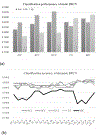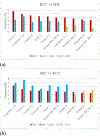MuscNet, a Weighted Voting Model of Multi-Source Connectivity Networks to Predict Mild Cognitive Impairment Using Resting-State Functional MRI
- PMID: 35548102
- PMCID: PMC9090182
- DOI: 10.1109/access.2020.3025828
MuscNet, a Weighted Voting Model of Multi-Source Connectivity Networks to Predict Mild Cognitive Impairment Using Resting-State Functional MRI
Abstract
The neurological disorder mild cognitive impairment (MCI) demonstrates minor impacts on the patient's daily activities and may be ignored as the status of normal aging. But some of the MCI patients may further develop into severe statuses like Alzheimer's disease (AD). The brain functional connectivity network (BFCN) was usually constructed from the resting-state functional magnetic resonance imaging (rs-fMRI) data. This technology has been widely used to detect the neurodegenerative dementia and to reveal the intrinsic mechanism of neural activities. The BFCN edge was usually determined by the pairwise correlation between the brain regions. This study proposed a weighted voting model of multi-source connectivity networks (MuscNet) by integrating multiple BFCNs of different correlation coefficients. Our model was further improved by removing redundant features. The experimental data demonstrated that different BFCNs contributed complementary information to each other and MuscNet outperformed the existing models on detecting MCI patients. The previous study suggested the existence of multiple solutions with similarly good performance for a machine learning problem. The proposed model MuscNet utilized a weighted voting strategy to slightly outperform the existing studies, suggesting an effective way to fuse multiple base models. The reason may need further theoretical investigations about why different base models contribute to each other for the MCI prediction.
Keywords: Alzheimer’s disease; Mild cognitive impairment; MuscNet; brain functional connectivity network; multi-source connectivity network; resting-state functional MRI; weighted voting model.
Figures








Similar articles
-
Application of advanced machine learning methods on resting-state fMRI network for identification of mild cognitive impairment and Alzheimer's disease.Brain Imaging Behav. 2016 Sep;10(3):799-817. doi: 10.1007/s11682-015-9448-7. Brain Imaging Behav. 2016. PMID: 26363784
-
Alzheimer's Disease Diagnosis and Biomarker Analysis Using Resting-State Functional MRI Functional Brain Network With Multi-Measures Features and Hippocampal Subfield and Amygdala Volume of Structural MRI.Front Aging Neurosci. 2022 May 30;14:818871. doi: 10.3389/fnagi.2022.818871. eCollection 2022. Front Aging Neurosci. 2022. PMID: 35707703 Free PMC article.
-
Fused Sparse Network Learning for Longitudinal Analysis of Mild Cognitive Impairment.IEEE Trans Cybern. 2021 Jan;51(1):233-246. doi: 10.1109/TCYB.2019.2940526. Epub 2020 Dec 22. IEEE Trans Cybern. 2021. PMID: 31567112
-
A survey on applications and analysis methods of functional magnetic resonance imaging for Alzheimer's disease.J Neurosci Methods. 2019 Apr 1;317:121-140. doi: 10.1016/j.jneumeth.2018.12.012. Epub 2018 Dec 26. J Neurosci Methods. 2019. PMID: 30593787 Review.
-
Three Large-Scale Functional Brain Networks from Resting-State Functional MRI in Subjects with Different Levels of Cognitive Impairment.Psychiatry Investig. 2016 Jan;13(1):1-7. doi: 10.4306/pi.2016.13.1.1. Epub 2015 Nov 20. Psychiatry Investig. 2016. PMID: 26766941 Free PMC article. Review.
Cited by
-
k- Strong Inference Algorithm: A Hybrid Information Theory Based Gene Network Inference Algorithm.Mol Biotechnol. 2024 Nov;66(11):3213-3225. doi: 10.1007/s12033-023-00929-2. Epub 2023 Nov 11. Mol Biotechnol. 2024. PMID: 37950851
References
-
- Bangen KJ, Werhane ML, Weigand AJ, Edmonds EC, Delano-Wood L, Thomas KR, Nation DA, Evangelista ND, Clark AL, Liu TT, and Bondi MW, “Reduced regional cerebral blood flow relates to poorer cognition in older adults with type 2 diabetes,” Frontiers Aging Neurosci., vol. 10, p. 270, Sep. 2018, doi: 10.3389/fnagi.2018.00270. - DOI - PMC - PubMed
-
- Vos SJB, Verhey F, Frölich L, Kornhuber J, Wiltfang J, Maier W, Peters O, Rüther E, Nobili F, Morbelli S, and Frisoni GB, “Prevalence and prognosis of Alzheimer’s disease at the mild cognitive impairment stage,” Brain, vol. 138, no. 5, pp. 1327–1338, May 2015, doi: 10.1093/brain/awv029. - DOI - PMC - PubMed
Grants and funding
LinkOut - more resources
Full Text Sources
